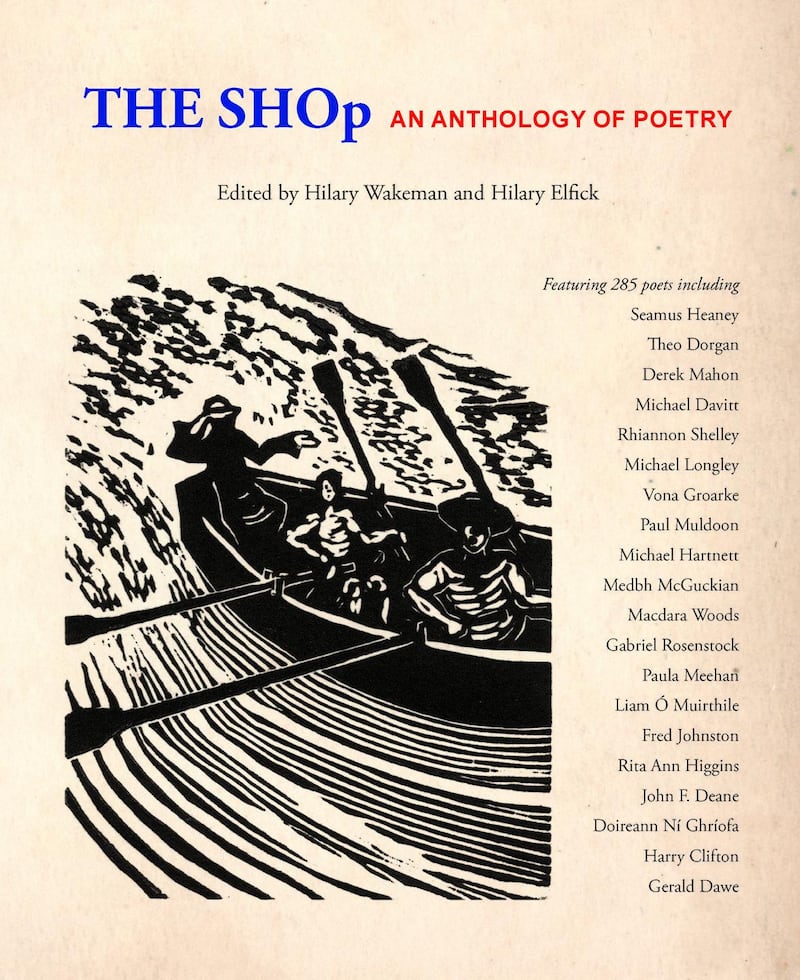THE SHOp. Odd name for a poetry magazine. And why the lower case ‘p’ at the end? And wasn’t it a bit crazy to start a poetry magazine in the far southwest of rural Ireland, two hours’ drive beyond Cork city?
But that magazine became recognised as one of the best Ireland has ever produced. Seamus Heaney, who was a fan – and became its patron, anonymous until now – said of it: ‘First class goods, beautifully presented. Congratulations from this confirmed SHOp-lifter.’
John Montague wrote: ‘THE SHOp looks like being the best poetry magazine in these islands.’ Gerard Smyth, poetry editor of The Irish Times noted: ‘John Wakeman and his wife Hilary created a communal home for Irish poetry.’ Karen O’Connor said: ‘THE SHOp changed the face of poetry in Ireland and that should be remembered and celebrated.’
It was beautiful to look at with plenty of white space ‘so the poems can breathe’, and a pleasure to hold. It published ‘big name’ poets but also ones who had never been published before, whose work impressed the editors. And it was loved. By its readers and subscribers, and especially by its contributor poets and artists, most of whom felt a personal connection between themselves and John Wakeman, the founder and editor of THE SHOp, and with Hilary, his wife and eventual co-editor.
The magazine began in 1999 and published for 15 years before closing to much dismay in 2014. But a few months ago a long-time subscriber asked why there wasn’t an anthology highlighting the best from THE SHOp. Contributors and friends of THE SHOp were consulted and the response was amazing, some noting that ‘it’s part of Irish literary history!’ The poet Hilary Elfick said she wanted to be involved, and David Givens at the Liffey Press said he’d be delighted to publish it.

The editors then had the enormous task of deciding which poems to include so started going through all 47 volumes, gradually narrowing down the list to pick the ones that would make the cut. What were they looking for? An element of surprise, something not said before or not in that way, precise vocabulary with no words wasted? Were they moved, startled, arrested? Did they want to read it again? And maybe again? The editors decided that as a rule there should be no more than one poem from each poet. For those poets who had appeared in the magazine more than once or frequently, they decided on which of their poems to include.
And then there were the Irish poems. The original magazines had always included at least one poem in Irish, with a translation, and the anthology wanted to continue that practice. Since neither editor read Irish, decisions were based on the English language translation, and then Irish language poet Gabriel Rosenstock was asked to help with the final choices.
The anthology, it was commonly felt, should as far as possible resemble the original magazines. This was a challenge for the Liffey Press as the editors’ preferred trim size, format, paper and layout would add considerably to the costs, always an issue for a book with a limited market. Adding to the difficulty was the fact that good digital copies of the poems and artwork were for the most part not available, which meant much scanning and re-typing plus some additional expenses.
Though the editors feel strongly that poets and artists should be paid for their work – as indeed they were when originally submitting their pieces to the journal – with 285 poets and translators, and 16 illustrators plus the cover artist, even €50 each would have come to over €15,000, entirely obliterating a budget that was already underfunded.
One possible solution was to apply to the Arts Council for funding, but their decision-making process meant that the book wouldn’t come out until the new year – with no guarantee of a grant – and getting the book out in time to add to the Christmas cheer was a definite priority. Unfortunately, this meant that some funding still needed to be found.
Once again the contributors and friends of THE SHOp came to the rescue. An email was sent out explaining the problem and soon thereafter a stream of donations began to appear. With the help of one particularly generous benefactor, this meant that at least the publication costs could be met and THE SHOp: An Anthology of Poetry would see the light of day.
The final result is an absolute delight. It is the product of many tough decisions followed by hours and hours of hard work. Without question it could not have been done without the help of others, in particular Theo Dorgan who advised the editors all along the way, and Brian Lalor who provided the wonderful woodblock print for the cover.
Available from good bookshops and directly from the Liffey Press, THE SHOp: An Anthology of Poetryis priced at a very reasonable €19.95. What better Christmas gift in these very difficult times?
And the odd name? It came from William Butler Yeats’ poem The Circus Animal’s Desertion:
… Now that my ladder’s gone
I must lie down where all the ladders start,
In the foul rag-and-bone shop of the heart.
And that idiosyncratic lower case ‘p’ in the title? It was the whim of the early magazine designer, Joakim Säflund, and thankfully has been an endless talking point ever since.












